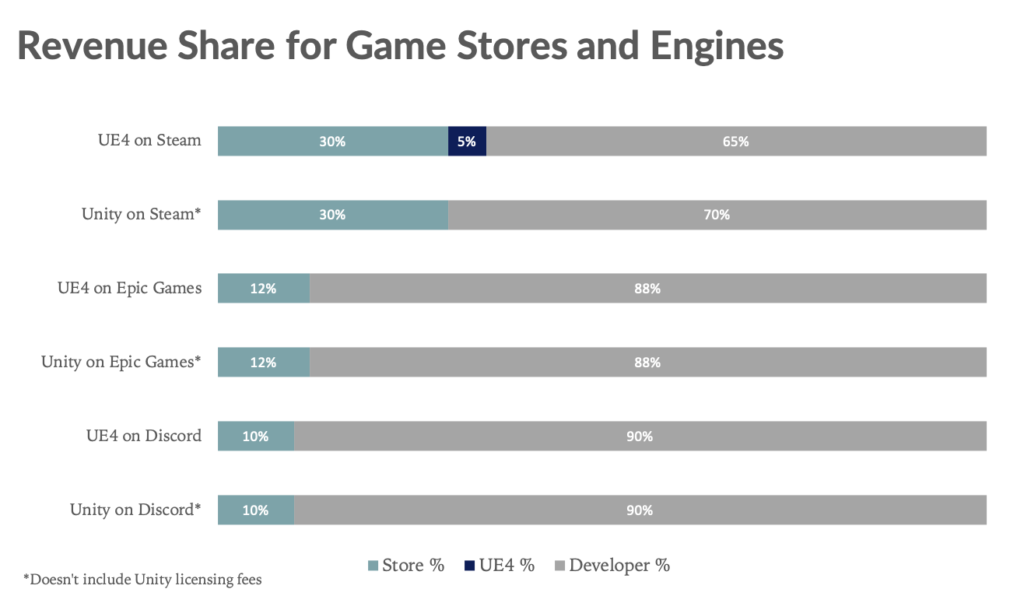On the back of Discord’s latest funding round, we’re taking a look at the current landscape for PC game stores. Earlier in December, Epic Games announced their own game store that would give developers a higher share of revenue compared to the existing Steam store (Steam has traditionally given 70% to developers and kept 30%, Epic Games is offering 88/12 split in favor of developers). Soon after, Discord announced that their game store (launching in 2019) would give developers an even greater share: 90% share of revenue. In response to growing competition, Steam recently revised their revenue share model. When a game makes over $10 million on Steam, revenue share is adjusted to 75/25 and at $50M+ to 80/20. Each new game store is trying to entice developers by offering a larger share of revenues. Currently, the three game stores and their revenue splits look as follows:

What is important for game distribution platforms?
Traditionally, a 70/30 split has been the norm, not just for games but also app distribution (this is the split for the Google Play Store and Apple App Store), but developers don’t always feel that game stores are earning their 30% share of revenue.
When considering how these announcements will impact the game store landscape, it’s helpful to start by looking at what value game stores provide players.
Discoverability. Players often go to a game store with a specific game in mind, but stores make it easy for players to find new games. through recommendations, targeted sales, and promotions to entice players to purchase new games.
Community. Players want to be engaged with games that they love. Forums, a mod workshop, instant messaging, a marketplace to trade and buy in-game items, and the ability to stream gameplay to other users through the Steam client are all features that have contributed to Steam’s popularity. These are important features to players and can ultimately increase a game’s popularity and lifespan.
Player Protection. Game stores protect players from being taken advantage of by publishers. A good example is Steam’s return policy: Steam mandates that any game on its store must accept returns if a player has purchased the game within 14 days and has played the title for less than two hours.
Ultimately, players are going to choose a game store that has the games they want to play. Today, the game store of choice remains Steam given its library, past purchase history, payment information, and more. If a developer tries to reach a Steam user through a different game store or via a direct download, there is an additional barrier. While this isn’t necessarily a deal breaker (Fortnite has its own launcher and will soon be in the Epic Games store, League of Legends has its own download), it can matter for non-AAA titles.
What is important for developers?
Player Network. The primary goal for most game developers is to reach as many players as possible. Game stores offer access to large player networks that developers hope to reach.
Distribution. In order to reach players, game stores provide distribution services for developers. Not all game developers are able to create their own launchers or provide their games for download on a website. This is less important for developers of AAA titles.
Revenue Share. Developers want to earn what they deem a fair share of revenue. Traditionally, this has been a 70/30 split, but with alternative options, developers will begin factoring in revenue share more when making game store decision.
Developers can choose to distribute their content in as few or as many game stores as they like. The decision about how to distribute, whether via stores and/or on their own, becomes a simple logical problem if the main goal is to maximize revenues net of game store costs. Assuming the same conversion rate across all channels, this means a publisher needs to be able to generate the same awareness given an advertising and delivery budget, including staffing, equivalent to the expected payout to a game publishing platform like the Steam store. For most publishers, it will be difficult to create effective enough advertising to reach and convert at the same level, thus it usually won’t make sense to distribute directly if the goal is net revenue maximization.
In the traditional retail model, game developers and publishers together would get about 40-60% of revenue at best. Once PC distribution moved online, the 70/30 developer/publisher split made sense because the traditional retail channel was eliminated, and it cost less to distribute the games. Steam quickly emerged as the dominant publishing service and was able to keep that ratio even as their superior services made them by far the best platform. Now that costs to distribute have come down even further with cheaper storage, faster internet, and economies of scale, developers are seeking a larger share prompting new competitors like Epic and Discord to enter the market. This will lead to a better revenue share for developers no matter the platform(s) they choose.
What does this mean for the future of online game stores?
For the existing game store of choice, Steam, there are two risks: 1) additional competition from Epic Games and Discord, and 2) publishers distributing their games directly.
Direct competition from Epic Games and Discord. Discord’s entrance as a store is the biggest threat to Steam because of Discord’s large user base that uses the platform for chat during games, to connect with a community, and to find new people to play with. Next to Steam, it’s probably the largest gaming community in the world at 90 million monthly active users. Steam recently updated their chat and social features to compete with Discord, but Discord remains popular for chat even when players use Steam as their game launcher.
Despite many gamers already using Discord for other services, there isn’t a clear incentive for users to move to a completely new platform for game purchases. For a long time, Discord has served the chat function, and Steam has been the game store. Players have their purchase history and a bulk of their library in Steam. This not only makes the launch process easy but also provides accurate recommendations for new games that players may be interested in.
While the revenue share between Steam and publishers may have to change, the announcement of the Discord and Epic Games stores doesn’t mean that Steam has to match the 90/10 revenue share model. Steam simply needs to justify their share of revenue and continue to provide the right amount of value to developers — more value than Discord and Epic if they intend to charge more.
Publishers distributing their games directly. The bigger risk for game stores is that more developers choose to sell their titles direct, which we’ve seen from Activision/Blizzard and, more recently, Bethesda. These developers don’t need to rely on the user curation aspect of the Steam store because they already have a dedicated userbase and spend a lot of money marketing their games. This is likely why Steam has implemented changes increasing the amount of revenue they share with large developers. Titles from larger publishers are more likely to have other forums and websites dedicated to sharing information, gameplay, and mods, so they don’t benefit as much from those features through Steam, making it more difficult for Steam to justify their 30% cut. Given Steam didn’t make this change for all developers signals they are confident other game distributors can’t yet match the platform they have created.
The good news for players is that more game stores means more differentiation from the competitors via improving or adding features that support their communities, like Steam’s recent overhaul of its chat service. In addition, a higher revenue share for developers should mean better games for players. Developers will be able to better support their games after they are launched as the barrier to creating a profitable game is lower.
The bad news for players is that they will likely have to rely on multiple launchers to access their full game library and protections that Steam offered may go away as publishers create their own launchers and create their own policies. But this seems like a small price to pay for a more competitive marketplace.
Disclaimer: We actively write about the themes in which we invest or may invest: virtual reality, augmented reality, artificial intelligence, and robotics. From time to time, we may write about companies that are in our portfolio. As managers of the portfolio, we may earn carried interest, management fees or other compensation from such portfolio. Content on this site including opinions on specific themes in technology, market estimates, and estimates and commentary regarding publicly traded or private companies is not intended for use in making any investment decisions and provided solely for informational purposes. We hold no obligation to update any of our projections and the content on this site should not be relied upon. We express no warranties about any estimates or opinions we make.
